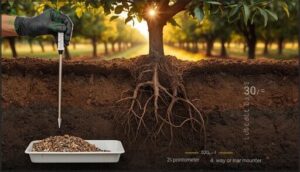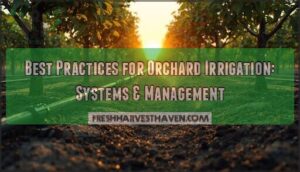This site is supported by our readers. We may earn a commission, at no cost to you, if you purchase through links.
Your orchard’s productivity doesn’t begin with pruning shears or spray schedules—it starts beneath your boots, where roots navigate a complex underground landscape. Soil health determines whether your trees access the nutrients they need, withstand drought stress, and produce consistent yields year after year. Yet many growers discover too late that compaction, pH imbalances, or depleted organic matter have quietly undermined years of careful management.
Managing orchard soil health requires understanding how temperature, structure, microbial activity, and nutrient cycling work together as an integrated system. The strategies ahead will help you assess your soil’s current condition and implement practical improvements that protect your investment from the ground up.
Table Of Contents
Key Takeaways
- Soil health starts with managing five interconnected factors—temperature (64°F–77°F ideal), pH (6.0–6.5 range), organic matter (each 1% adds 20–30 lbs nitrogen/acre), water-holding capacity, and compaction—that together determine whether your trees access nutrients, resist stress, and produce consistent yields.
- Regular testing every 2–3 years using frameworks like the Cornell Soil Health Test gives you baseline data on pH, organic matter, microbial activity, and compaction levels, allowing you to measure what’s actually happening below ground before making costly management decisions.
- Strategic use of compost (1–5 tons/acre), cover crops (reducing erosion by 99%), woody mulches (boosting moisture 6.5%), and reduced tillage protects soil structure and builds organic matter without requiring expensive equipment or drastic operational changes.
- Pre-plant diagnostic testing for nematodes and pathogens combined with biofumigation using brassica cover crops cuts disease pressure by 40–85% while building beneficial microbial communities that act as your orchard’s immune system against soil-borne threats.
Key Factors Influencing Orchard Soil Health
Your orchard’s soil is more than just dirt—it’s a living system that determines how well your trees grow, resist stress, and produce quality fruit. Getting soil health right means understanding the factors that either support or sabotage root development and nutrient uptake.
Let’s look at five critical elements every grower needs to manage for long-term orchard success.
Optimal Soil Temperature for Fruit Tree Roots
Below the surface, soil temperature shapes everything from root growth to nutrient uptake rates. Your orchard soil works best when the root zone stays between 64°F and 77°F—the sweet spot where apple roots thrive. To maintain ideal soil health, accurate timing of nutrient applications is essential, as soil temperatures affect nutrient uptake.
- Monitor temperatures; anything above 86°F damages roots
- Apply mulching benefits to buffer temperature stress effects
- Use irrigation cooling during heat waves
This foundation bolsters vigorous root growth optima year-round.
Importance of Soil PH and Nutrient Availability
While temperature lays the groundwork, soil pH acts as a gatekeeper for nutrient uptake. Aim for a pH range of 6.0–6.5 to enable availability of nitrogen, phosphorus, potassium, and calcium. Below 5.5, aluminum toxicity threatens roots and macronutrient effects suffer. Above 7.0, micronutrient availability plummets, starving trees of iron and zinc.
Regular pH management through pre-plant liming protects your soil fertility investment and keeps nutrient cycling on track. Good pH levels are important because phosphorus availability is limited in high pH soils.
Role of Soil Organic Matter in Nutrient Cycling
Beyond pH control, you’ll find that soil organic matter drives nutrient cycling like nothing else. Think of it as your orchard’s nutrient bank—with 58% carbon, it stores and releases nitrogen, phosphorus, and sulfur right when trees need them most. Each 1% increase delivers 20–30 pounds of nitrogen per acre annually.
- Soil organic matter fuels microbial decomposition, transforming nutrients into plant-available forms
- Enhanced nutrient retention through improved cation exchange capacity prevents leaching losses
- Carbon sequestration builds stable humus that binds and protects soil nutrients
- Nitrogen mineralization peaks during spring and summer, matching crop demand cycles
- Better soil structure from organic matter increases root access to the soil fertility pool
Microbial communities thrive in organic-rich environments, accelerating the breakdown and recycling that keeps soil biology productive. Your management of organic inputs directly shapes how efficiently nutrients move through the system.
Water-holding Capacity and Soil Structure
Water-holding capacity hinges on soil texture and aggregate stability—clay-rich soils retain up to 50% more moisture than sandy ones. Fine-textured sites average 22–26% volumetric content versus 8–12% in coarse soils, meaning you’ll irrigate sandy blocks twice as often.
| Soil Property | Impact on Water Retention | Management Benefit |
|---|---|---|
| Aggregate stability | Increases infiltration by 200% | Reduces runoff, improves absorption |
| Organic matter incorporation | Raises capacity 32% over controls | Extends irrigation intervals |
| Erosion severity | Reduces retention 54–75% in degraded soils | Highlights need for erosion control |
Woody organic recycling boosts water infiltration dramatically, improving your orchard’s drought resilience while stabilizing soil structure against erosion effects.
Effects of Soil Compaction on Root Growth
Compaction creates a hidden bottleneck that crushes your orchard productivity by 20% to 75% through mechanical impedance blocking root penetration. Dense soil drops oxygen diffusion over 50%, starving roots while distorting their morphology into thicker, shorter forms with fewer lateral branches.
Poor soil structure restricts nutrient uptake and water movement, forcing roots into cracks instead of spreading freely, which weakens tree anchorage and long-term soil aeration.
Assessing and Monitoring Soil Health in Orchards
You can’t improve what you don’t measure, and that’s especially true for orchard soil health. Before you start making changes, you need to know where your soil stands right now.
Let’s walk through the key indicators and methods that’ll help you get a clear picture of what’s happening beneath your trees.
Soil Health Indicators and Testing Methods
You can’t manage what you don’t measure—that’s why soil health indicators matter. Start with the Cornell Soil Health Test or similar soil health assessment frameworks to establish baselines for your orchard.
Key metrics include soil pH (often 3.9–4.4 in tree rows), organic matter content, nutrient levels, aggregate stability, and soil biota populations. These orchard soil health assessment methods give you the data to make informed decisions.
Evaluating Soil Biological Activity
Tracking microbial activity reveals what’s happening below ground in your orchard. Organic systems show 41% higher microbial biomass carbon and 51% more microbial biomass nitrogen than conventional soils, directly reflecting healthier soil biological activity.
Focus on these indicators:
- Soil respiration: Measures active microbial communities breaking down organic matter
- Enzyme activity: Key enzymes like urease and dehydrogenase indicate nutrient cycling efficiency
- Earthworm activity: Higher populations signal improved soil structure and nitrogen mineralization
- Nematode activity: Beneficial nematodes show active nutrient cycling
- Total bacterial biomass: Organic orchards reach 7.4 × 10⁸ cells per gram
These soil microorganisms drive the biological processes that feed your trees.
Monitoring Soil Compaction and Aggregate Stability
Your orchard’s hidden damage often lives in compressed soil layers that choke root growth. Bulk density above 1.6 g/cm³ in loam soils restricts rooting for most fruit trees, while penetration resistance around 2 MPa (290 psi) strongly inhibits root elongation.
Measure compaction thresholds using a penetrometer near field capacity, and test aggregate stability through wet sieving to identify zones where orchard traffic has degraded soil structure.
Analyzing Soil Fertility and Nutrient Cycling
Fertility monitoring captures your orchard’s nutrient cycling patterns through soil testing every 2–3 years. Track biological activity indicators like microbial biomass and enzyme levels—sod culture systems show 20% higher microbial carbon than clean tillage.
Check pH between 6.5 and 7.2 for best nutrient availability. Amendment effects from compost or biochar boost soil nutrients by over 20%, improving management outcomes and long-term cycling efficiency.
Practical Strategies to Improve Orchard Soil
You’ve tested your soil and identified what needs work—now it’s time to put that knowledge into action. The good news is that improving orchard soil doesn’t require expensive equipment or drastic changes to your operation.
Let’s walk through four proven strategies that growers use to build healthier, more productive soil over time.
Incorporating Organic Matter and Compost
Think of organic matter as a long-term investment in your orchard’s productivity. Compost application rates of 1–5 tons per acre annually boost soil organic matter, water-holding capacity, and nutrient cycling while supporting disease suppression through beneficial microbial communities.
You’ll need to test compost quality risks—especially heavy metals and salts—before spreading, ensuring your organic amendments deliver soil health improvement without introducing problems down the road.
Managing Cover Crops and Ground Covers
Beyond compost, cover crops and groundcover management deliver measurable wins. Annual cover crops cut erosion by 99% while boosting water retention up to 629% in compacted soils. Perennial ground covers reduce weed pressure by 36%, lowering herbicide reliance.
Termination timing matters—later mowing strengthens weed suppression benefits. Cover crop selection should match your soil’s biggest challenge, whether that’s compaction, erosion runoff control, or nutrient cycling gaps.
Using Woody Mulches for Moisture and Temperature Control
Mulch application rates determine success—0.50 kg/m² hits the sweet spot for water availability without triggering runoff. Wood chip mulch boosts soil moisture by 6.5% while cutting evaporation 40%, and it moderates soil temperature swings that stress roots.
Mulch material types matter: woody options outperform living mulches for water-holding capacity. You’ll see microclimate modification benefits within months—trunk growth jumps 5–12%, with long-term benefits including reduced irrigation needs by up to 35%.
Minimizing Soil Disturbance for Soil Structure
Beyond mulching, you need to protect what’s underneath. Reduced tillage or no-till systems increase aggregate stability by 20–50% compared to conventional plowing, keeping soil structure intact. When you minimize disturbance, you preserve fungal networks that bind particles together and boost carbon sequestration. Residue retention on the surface protects organic matter from rapid breakdown while improving water infiltration.
- Limit tillage depth and frequency to maintain aggregate protection and prevent exposing organic matter to oxidation
- Use strip tillage in tree rows when establishing cover crops, disturbing only narrow zones rather than the entire alleyway
- Avoid working wet soils to prevent compaction and plow pans that restrict root growth for years
- Leave crop residues on the surface to feed soil biota, strengthen fungal networks, and improve long-term soil structure
Managing Water and Nutrients for Healthy Soil
Getting water and nutrients right isn’t just about feeding your trees—it’s about building soil that works for you season after season. Too much water, too little, or nutrients locked up where roots can’t reach them, and you’ll see it in everything from fruit quality to root health.
Let’s walk through how to balance irrigation, prevent common nutrient disorders, improve drainage, and keep your soil cycling nutrients efficiently.
Balancing Irrigation to Prevent Water Stress
Water productivity depends on precise soil water management. Deficit irrigation can improve yields and water-use efficiency—regulated strategies boosted productivity up to 53% in multi-year trials—while overirrigation risks root disease, oxygen depletion, and pathogen spread through runoff.
Monitoring status with soil moisture sensors and plant indicators helps you calibrate irrigation design to maintain adequate water availability, improve waterholding capacity, and protect water infiltration without saturating root zones or compromising tree health.
Preventing Calcium-related Disorders
When soil pH drops below 6.0, calcium uptake declines sharply, raising the risk of bitter pit and internal breakdown—disorders that account for 5% to 10% of annual postharvest losses.
You’ll need to maintain ideal leaf calcium levels between 1.14% and 1.30% through regular foliar sprays and careful nutrient balance, adjusting rates based on cultivar susceptibility to protect fruit quality.
Enhancing Soil Drainage and Preventing Runoff
Proper tile drainage lowers your water table within 15–30 cm after heavy rain, protecting roots and boosting cover crop biomass by over 3,100 pounds per acre. Organic amendments like compost reduce runoff by up to 91%, while cover crops cut soil erosion by 85.6%.
Deep tillage breaks compaction, improving water infiltration. Precision irrigation minimizes excess water, preventing runoff and supporting best tree growth through smart water management in orchards.
Optimizing Nutrient Cycling for Fruit Trees
When you integrate water and nutrients strategically, nitrogen can drive up to 50% of your fruit yield. SOM decomposition and cover crop cycling steadily release essential soil nutrients, while enzyme dynamics power nutrient cycling beneath your trees.
Mulch application boosts nutrient availability, and precise timing of fertilizer paired with controlled irrigation maximizes soil fertility.
Improving soil fertility translates directly into better fruit quality and stronger water-nutrient integration.
Protecting Orchard Soils From Pests and Diseases
Protecting your orchard soil from pests and diseases requires a proactive approach that starts well before planting. Soil-borne pathogens, nematodes, and other threats can undermine even the best management practices if left unchecked.
Here’s how you can identify risks, suppress diseases naturally, and build a microbial community that works in your favor.
Identifying and Managing Soil-borne Pathogens
Your orchard’s underground world harbors threats you can’t see until damage appears. Pathogen diagnostic testing—especially PCR methods that identify root rot, nematodes, and other soilborne diseases—gives you a 95% accuracy rate before planting. This proactive step cuts disease spread by 30%.
- Root pathogen pressure from fungi and nematodes drains your trees’ vigor silently
- Replant disease control starts with knowing what lurks in your soil
- Beneficial soil microbes like Trichoderma suppress pathogens when populations stay balanced
Biofumigation and Disease Suppression With Cover Crops
When you turn under brassica cover crops, glucosinolate hydrolysis releases isothiocyanates—nature’s fumigant that slashes root pathogen pressure by 40-85%. This biofumigation tactic cuts soilborne diseases while boosting microbial interconnectivity and soil health without synthetic chemicals. Mustard and radish varieties work best, though biofumigation limitations exist: effects stay weaker than chemical fumigants, and pathogen reduction varies with your soil conditions and timing.
Pre-plant Diagnostic Testing for Nematodes
Before you plant, think of nematode tests as your insurance policy against catastrophic crop loss.
Pull 15 soil cores per five acres down to 10-12 inches, mixing 10-25 subsamples for reliable detection. Lab methods identify species-specific thresholds—just one nematode per 500 cc can warrant action in high-value orchards.
Test preplant and every 3-5 years to track distribution patterns and protect root health against soilborne diseases in orchards.
Supporting Beneficial Soil Microbial Communities
Beyond testing for pathogens, you can actively seed your soils with allies. Mycorrhizal inoculation and compost microbiome amendments boost soil biological activity, while reduced tillage preserves microbial networks.
Cover crop diversity feeds soil biota year-round, and bioinoculant benefits include halving tree mortality in high-disease sites.
Think of soil microbial communities as your orchard’s immune system—manage them well, and they’ll manage threats for you.
Manage your soil’s microbial communities like an immune system, and they’ll defend your orchard against threats
Frequently Asked Questions (FAQs)
How often should orchard soil be tested?
Testing frequency depends on soil type, orchard age, and crop rotation schedules. Sandy soils need assessment every 2–3 years, while clay-based orchards can wait 3–5 years. Problem diagnosis may require annual testing.
Can soil health recover after years of neglect?
Yes, soil health can recover after years of neglect. Recovery timelines vary—microbial respiration and chemical recovery often show improvement within a year, while physical properties and ecosystem productivity may require five to ten years of sustained remediation efforts.
What amendments work best for acidic orchard soils?
Like a key unlocking soil fertility, lime application raises pH effectively in acidic orchards. Gypsum benefits deeper layers without altering pH.
Organic matter, biochar effects, and wood ash improve nutrient availability through strategic soil amendments.
How does tillage timing affect soil biology?
Tillage timing impacts soil biology substantially because microbial respiration, enzyme activity, and fungal dominance peak in spring. Disturbing soil when microbial communities are most active disrupts carbon fluxes and weakens beneficial soil health functions critical for nutrient cycling.
Are synthetic fertilizers compatible with soil health goals?
When a fertilizer boosts microbial biomass and soil fertility by 20–30% alongside organic matter, it’s compatible with soil health. Balanced nutrient use efficiency and physical structure effects confirm synthetic fertilizers can support sustainable agriculture goals.
Conclusion
What you sow below ground, you harvest above it—that principle holds true whether you’re building soil structure or boosting microbial life.
Managing orchard soil health isn’t a seasonal task; it’s the foundation that carries your operation through droughts, diseases, and years of production.
The strategies you’ve explored here give you the tools to turn compacted, depleted ground into a living system that fosters vigorous growth. Your orchard’s future productivity depends on the choices you make today beneath the surface.
- https://treefruitresearch.org/report/how-do-we-measure-and-manage-soil-health-for-productive-orchards/
- https://www.sjvtandv.com/blog/l43ucibv3ctotrrrlm18e4qj3qzmmj
- https://journals.plos.org/plosone/article?id=10.1371%2Fjournal.pone.0038883
- https://farmland.org/soil-health-case-study-findings
- https://agwater.extension.wisc.edu/articles/cover-crop-selection-and-management-to-reduce-nitrate-leaching-risk/











